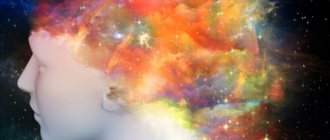There are a huge number of myths and misconceptions about psychiatry among people. As a practicing doctor, I encounter this phenomenon all the time. You can hear so many ideas and suggestions for treatment from patients and their loved ones!
Just a few days ago, the mother of a patient suffering from schizophrenia suggested that her daughter undergo an “intestinal drainage” in order to “get rid of the sludge that leads to hallucinations.” Another mother of a mentally ill patient insisted on massage of the prostate gland for approximately the same purpose. I am even afraid to count how many proposals I have listened to regarding the treatment of mentally ill patients with urine therapy, honey, mud, physical activity and diets.
More than once I was asked to “scare the patient more strongly” - “because stress will make the disease go away,” they insisted on immersing the patient in ice water on the feast of Epiphany. And the rituals of reprimand or exorcism of the most varied scale... I think that if I followed the lead of these well-wishers, I would risk ending up in the hospital or, what’s the best, behind bars. It would be difficult to explain to “competent comrades” why I immersed a sick person in wormwood against his will... A lot of myths and misconceptions are associated with schizophrenia. As often as not, “in the world” our patients are called “crazy”, “fools”, “seizures” - without even imagining the essence of the changes happening to them, and therefore without understanding the peculiarities of their behavior, views on life, the world around them. This is called stigmatization: in essence, people deny patients the same rights as others - only due to a lack of understanding of their illness.
I will try to lift the veil of misunderstanding a little and tell you what actually happens to mentally ill people, using the example of one of the most common and severe phenomena in psychiatry.
Kandinsky-Clerambault syndrome (mental automatism syndrome; external influence syndrome, influence syndrome, alienation syndrome, mastery syndrome) is a psychopathological symptom complex manifested by alienation or loss of belonging to one’s own mental processes (mental, sensory, motor) in combination with a feeling of influence some outside force; accompanied by delusions of mental and physical influence and (or) delusions of persecution, perceptual disorders. Mental automatism syndrome can be observed in various mental illnesses: alcoholic, traumatic, vascular, infectious psychoses. It is most characteristic of schizophrenia, especially its paranoid form, and almost always indicates an unfavorable prognosis for the course of the disease.
"Hunters" and victims
The first comprehensive description of the symptoms of this disorder belongs to the Russian psychiatrist Viktor Khrisanfovich Kandinsky (1849–1889), who in 1880 published a chronicle of his own illness, “On the Doctrine of Hallucinations,” where he gave a detailed description of the observed mental disorders. In 1881, a German translation of the book was published, which quickly received responses in Germany and France.
Almost 40 years later, Gaëtan Henri Alfred Eduouard Léon Marie Gatian de Clérambault (1872–1934), a French psychiatrist, compiled a classification of the symptoms identified by Kandinsky and combined them into a syndrome, which he received name: Kandinsky-Clerambault syndrome.
Thus, Kandinsky and Clerambault independently described the syndrome of mental automatism. It is noteworthy that both psychiatrists analyzed and described their own painful experiences. They were both sick, and both eventually led to suicide.
History
| « | Having the misfortune of suffering from hallucinatory insanity for two years and retaining after recovery the ability to cause a certain kind of hallucination at will, I was naturally able to notice in myself some of the conditions for the origin of sensory delirium. | » |
| - psychiatrist Kandinsky. | ||
The syndrome is named after Viktor Kandinsky, the second cousin of the artist Wassily Kandinsky. In 1876-1877 Victor served in the navy as a ship’s doctor, participated in the Russian-Turkish War and suddenly felt that he had been “subjected” to the mental attack of the Tsarist secret police. But he seized control in time and went to psychiatry himself, where he was able to describe his experiences in the critical-clinical study “On Pseudohallucinations,” which was highly praised in his works by the luminary of psychiatry, Jaspers. In addition, he is considered the father of Russian forensic psychiatry.
To stop external “influence” on his brain, he committed suicide in the name of conspiracy at the peak of one of the attacks in 1889. through overload with substances.
There is not much interesting about the second half of the syndrome, about Clerambault: he was a similar schizophrenic psychiatrist-schizophrenic from France, “controlled” by Surte (this is a French FSO) and, independently of Kandinsky, described his symptoms of mental automatism.
He also came up with erotic delusions (Clerambault syndrome), the law of his name, and then fell into depression with delusions of guilt and shot himself.
Symptoms of Kandinsky-Clerambault syndrome
This is a feeling of alienation from one’s own mental processes, of mastery by someone from the outside. Arises as a result of delusional ideas about the imaginary impact on the patient (for example, radiation or ultrasound).
Ideatorial, or associative, automatisms are the result of an imaginary influence on thinking processes and other forms of mental activity.
These include:
Mentism is a violent influx of thoughts and images beyond the patient's control.
A symptom of openness of thoughts is the feeling that thoughts are known to others.
“Thought withdrawal,” in which the patient’s thoughts “disappear” from the head.
“Made thoughts” is the belief that his thoughts belong to strangers, most often his persecutors, and are put into the patient’s head.
“Unwinding of memories”: patients, against their will and desire, as if under the influence of an outside force, are forced to remember certain events of their life; Often, at the same time, the patient is “showed pictures” illustrating memories.
The phenomenon of “made moods, feelings, dreams”: patients claim that their moods, feelings, likes and dislikes are the result of external influences. For example, there is a feeling that emotions do not arise independently, but under the influence of an outside force (“they laugh at me,” “they cry at me”).
Sensory or sensory automatisms usually include unpleasant sensations that also arise as a result of the imaginary influence of an outside force. They manifest themselves as a feeling of sudden heat or cold, painful sensations in the internal organs, head, and limbs. Most often they are unusual, pretentious: patients talk about extremely peculiar sensations in the form of twisting, pulsation, bursting of internal organs and body parts. For example, I heard from patients that “from radiation, the heart swells and buzzes like a bell” or “a plasticity has formed in the head... the brain has frozen, hardened...”; “My intestines are tied in knots - this is causing constipation...” The intestines were turned off, the brain was preserved, stopped - violence! In this case, there may be no real problems from the authorities at all.
Motor, or motor, automatisms include the feeling of external imposition of the movements performed by the patient. Patients believe that their actions are controlled, they move their limbs, tongue, cause a feeling of immobility, numbness, and deprive them of the ability to voluntarily move. Motor automatisms also include speech motor automatisms: patients claim that their language is spoken; the words they utter belong to strangers. So, a patient who has just scolded the doctor with the last words sharply begins to apologize: “Sorry, it’s not me... You are a good doctor, but your tongue moves in your mouth by itself...
Forms of the disease
Clerambault syndrome can occur in two phases:
- Acute (from several days to 3 months). The symptoms are pronounced. A person suffers from pseudohallucinations with the manifestation of delusional thoughts. He is active, talkative, aggressive and often gets irritated over trifles. Sometimes there is an unjustified feeling of fear. In some cases, the patient is so emotionally unstable that he completely falls out of normal functioning in society.
- Chronic (up to several years).
Symptoms increase gradually. They cannot be diagnosed at an early stage of the disease, so they often go unnoticed. First, signs of associative automatism appear, then sensory symptoms appear, and in severe cases, motor symptoms.
Pseudohallucinations
These phenomena are characteristic specifically of Kandinsky-Clerambault syndrome. These are visual, auditory, olfactory, gustatory and other deceptions of perception, distinguished by patients from real objects (i.e., the patient seems to “see them with his inner eye” or “hears them inside his body”) and have the nature of being made, artificial.
For example, the patient “sees” “made images”: faces, entire panoramas (similar to watching a movie), which are “showed” to the patient by his “persecutors” with the help of certain “apparatuses”. Auditory pseudohallucinations - noises, words, phrases “transmitted” by radio, through various equipment; they are most often localized in the head and body; have an imperative and commentary nature, belong to familiar and unfamiliar persons; can be men's, women's, children's.
For example, one of the patients very colorfully (at the peak of an acute condition) described to me “pictures of the future” that “alien angels” were “transmitting” into his brain. It looked, he said, like a filmstrip or slides that were shown to his inner “brain” eye. He described the contents of the “pictures” in detail, but due to other thinking disorders, he could not complete the description to the end, slipping into other topics.
We also constantly have to ask patients - where exactly do they hear “voices”? If a person reports that orders or swearing are heard inside the head, even in complete silence around, this is a serious sign of our syndrome.
Causes
The main cause of paranoid schizophrenia is a functional disorder of the brain. However, there are a lot of factors that can provoke it. One of the main ones, which scientists usually call, is genetic. In simple terms, the likelihood of developing schizophrenia is higher if there is or has been a history of mental disorders in the family.
Another factor is related to the hormone dopamine. Disruption of its production causes a malfunction in certain areas of the brain, which causes delusions and hallucinations.
Doctors also name risks that could hypothetically provoke symptoms of paranoid schizophrenia:
- infectious diseases in pregnant women;
- fasting during pregnancy;
- constant stress and depression;
- psychological childhood trauma;
- drug addiction and alcoholism;
- head injuries, including birth injuries.
These factors do not always lead to schizophrenia, however, if there is a genetic predisposition, when a person has relatives with similar diagnoses, all risks, especially alcohol and drugs, should be excluded.
Delusions of influence or persecution
The patient can explain his painful sensations by influencing him using a variety of methods - from witchcraft and hypnosis to modern means (electricity, UHF waves, radio waves, radiation, atomic energy, laser beams). The influence is carried out by both individuals and organizations, often with the goal of causing harm to the patient. For example, in my practice, which began in the late 90s of the last century, the most common complaints were about the “mafia or racketeers” (everyone remembers the dashing 90s !), as well as aliens from other planets and psychic sorcerers (remember the craze for parapsychology and ufology in the 80s and 90s!).
It is Kandinsky syndrome within schizophrenia that is characterized by delusions of persecution, interpretation, and influence. Other types of delusions are also inherent in other mental illnesses.
It is possible to develop an inverted version of Kandinsky-Clerambault syndrome: the patient himself supposedly has the ability to influence others, recognize their thoughts, influence their mood, feelings, and actions. These phenomena are usually combined with ideas of overestimation of one's personality or delusions of grandeur.
One of my regular patients, a fairly young girl, at the height of a schizophrenic attack, believed in “enormous magical power” emanating from her. She felt like “an all-powerful healer, connected by energy fields to the entire world,” and was unstoppable in her attempt to heal literally everyone who came into her sight. I must disappoint lovers of mysticism and energy therapy. The patient only seemed to be “guessing” the diagnosis, and she could not help anyone. But she made an excellent recovery and is now practically healthy.
Complications
Kandinsky-Clerambault syndrome is a complex disorder of mental and motor functions; its rapid progression threatens depersonalization. Signs of megalomania, the patient’s belief in his ability to mentally control other people, influencing their feelings and motor activity, most often accompany schizophrenia.
The danger of the situation is indicated by the complication of automatisms and the frequency of their occurrences. The progression ends in a severe personality disorder with loss of self-perception and immersion in a state of alienation.
When the delusional-hallucinatory variety of the syndrome is dominant, the main danger is depersonalization of the delusional type. In this case, the patient is convinced of a metamorphosis that has occurred to him, which has turned him into a being of a different type - an alien, a recruited agent, the shadow of another person. The pathology is difficult to treat and quickly becomes a mental defect.
Flow
Hallucinatory-paranoid syndrome within the framework of schizophrenia can develop acutely or become chronic. The acute form develops quickly, is characterized by a paroxysmal course, vivid, figurative, but poorly systematized delusions; variability, inconsistency of symptoms, intensity of emotions (not only fear, suspicion, hostility, but also high spirits), severity of mental automatisms.
The chronic form develops gradually, sometimes unnoticeably; can last for years. Usually the clinical picture becomes more complicated due to the accumulation of various automatisms. Delusional ideas are often systematized and directed. The patients’ sensations and imaginary sources of influence take on fantastic content (for example, their stomach was taken out, their intestines were blocked: they are being influenced from other continents with the participation of CIA employees, aliens).
External signs
There are several signs by which relatives of a sick person may suspect he has schizophrenia:
- He is isolated from society, sees friends less often, becomes increasingly withdrawn and does not share his experiences with family members.
- A person abandons his studies, stops showing up at the university or at work.
- Gradually, he begins to take less care of himself, does not shave, rarely washes and does not monitor the condition of his clothes.
- The patient is obsessed with various kinds of ideas, is interested in mystical and religious teachings, studies paranormal topics, etc.
- The person begins to hear worse, constantly asks again or does not respond to questions.
The difficulty is that the patient does not consider himself sick, so persuading him to undergo examination is not easy. This can often be done when the symptoms become more severe.
Diagnostics
The presence of Kandinsky-Clerambault syndrome is determined by signs of the unconscious emergence and development of mental disorders with an ever-increasing feeling of alienation and awareness of their violence.
In addition, as part of the diagnosis of schizophrenia, we pay attention to other mental disorders that are characteristic of the disease itself. Indeed, with schizophrenia, specific disorders of the emotional-volitional sphere, behavioral disorders, memory and intellectual disorders occur. Of great importance is the history of the development of the disease process, its stages, the role of heredity and the premorbid personality of the patient.
All this allows the psychiatrist to separate Kandinsky syndrome from other externally similar mental phenomena.
Treatment and prevention of mental automatism syndrome
To prevent the development of Kandinsky-Clerambault syndrome, timely treatment is necessary, usually in a psychiatric hospital. Complex therapy, as part of the treatment of the underlying disease - schizophrenia:
- medicinal (neuroleptics: haloperidol, trifluoperazine, clozapine, olanzapine, risperidone and other drugs);
- biological therapy - electroconvulsive, insulin comatose;
- psychotherapy (with the positive effect of psychotropic drugs) followed by social rehabilitation (at the stage of recovery and awareness of the disease).










